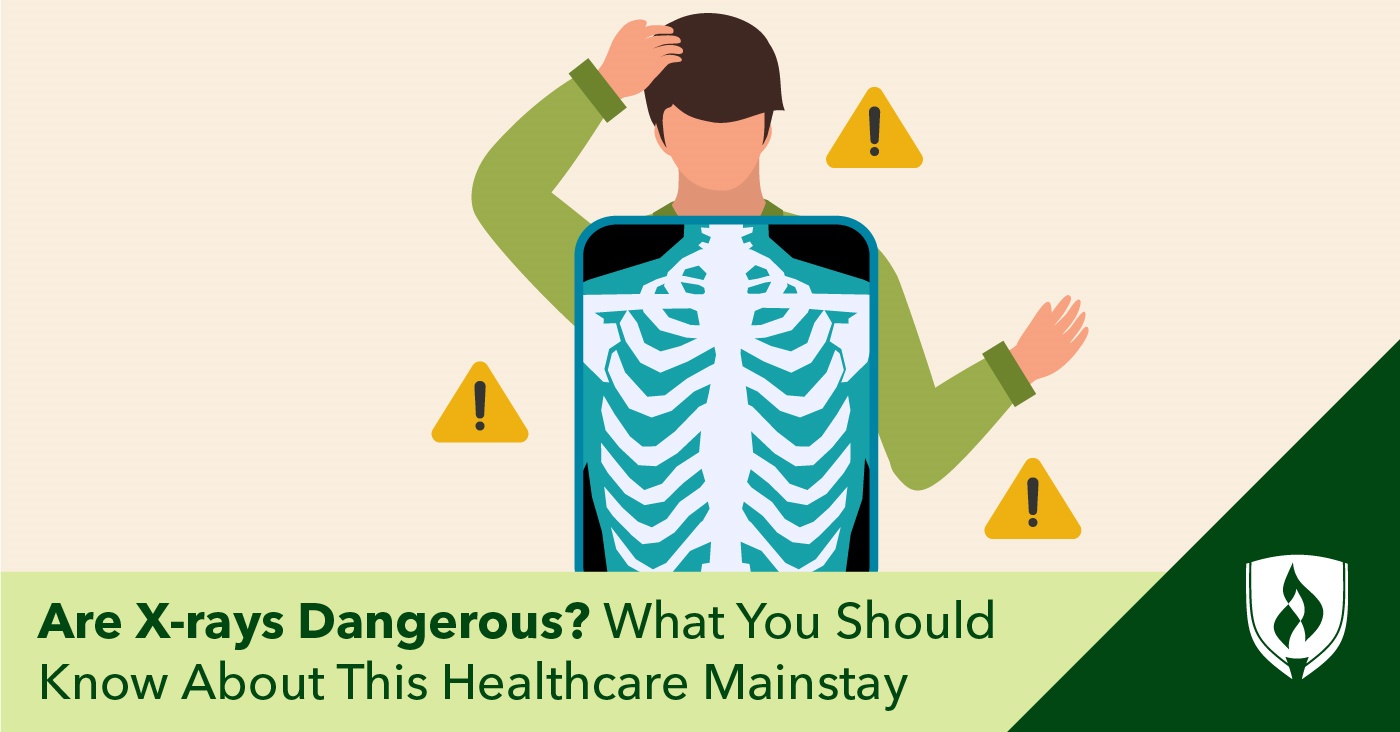Are X-rays Dangerous? What You Should Know About This Healthcare Mainstay
By Carrie Mesrobian on 07/05/2021

Whether it’s the “X-ray glasses” advertised on the back pages of old comic books or the amusing depictions of X-ray imaging found in classic cartoons, it’s pretty clear this useful technology had at one point captured the world’s imagination. That’s no surprise—X-ray images provide an objectively fascinating view into our bodies.
While some of the novelty has worn off as X-rays have become a much more routine part of healthcare, you still have some questions and curiosities you’d like to get to the bottom of. In this article, we’ll explore the origins of X-ray imaging, the potential dangers of X-rays and the measures taken to keep those dangers in check.
The early origins of X-rays
The discovery of X-rays was like so many scientific origin stories: an accident. In 1895, physics professor Wilhelm Roentgen of Wurzburg, Bavaria, was conducting experiments to see if cathode rays could pass through glass when a bright green light came out of the cathode tube.1 Soon, he found that this light, which he dubbed “X” as it was unknown, could pass through most other matter—most significantly, through human tissue. The excitement following this discovery spread quickly, prompting doctors to use the X-rays as a way to view internal injuries, broken bones and even foreign objects in startling detail.2
Enthusiasm for the new technology eclipsed safety concerns, prompting false claims that X-rays had miraculous “curative properties” while at the same time being used as a marketing gimmick; the most famous example of which was the Foot-O-Scope shoe-fitting device, which dazzled shoppers by showing them the bones in their feet.3 Over time, the physical effects of X-rays became alarmingly clear, and strong safety protocols evolved for use in healthcare settings.
Are X-rays dangerous?
Yes and no. Understanding the danger in X-rays requires awareness of how often we encounter them in our daily life. X-rays are a form of electromagnetic radiation naturally found on Earth. All of us are exposed to this kind of radiation from cosmic rays and the sun and in mineral and biological matter all around us. Residents of high altitudes are exposed to more radiation than those who live at sea level. Air travel also increases a person’s exposure as does the presence of radon in a home.
When it comes to danger, however, it’s important to note the scale. A typical chest X-ray involves about the same amount of radiation exposure as you’d receive from 10 days of natural “background” radiation.4 Lessening the risk and type of exposure is critical. With safety measures and judicious use, X-ray imaging is a powerful diagnostic tool in modern medicine.
What are the risks associated with X-rays?
The key risk in X-ray exposure involves damage to living cell tissue. Though the body usually can repair damage to cells, high-level exposures to radiation are often linked to cancer, chromosome mutations, congenital abnormalities and infant mortality rates. Following the widespread popularity of X-ray technology, there were clear indicators of the harms X-rays could cause. Skin would become irritated, appear sunburned and begin peeling after repeated exposure; many people with high levels of exposure suffered terribly and died soon afterward of aggressive cancers. Much of this data comes from research on the survivors of the Chernobyl nuclear plant accident in 1986 and the atomic bomb blasts in Japan in 1945.5 Many of the safety precautions for modern X-ray use were developed in response to these tragedies.
Why are X-rays used in medical care?
X-rays provide doctors with internal images of the body, offering detailed information about injury or illness that might be difficult to see without invasive surgery. Bones are the most visible, showing up as white due to calcium content while tissue and organs appear as grey.6 X-rays can give doctors still (radiography) or fluid (fluoroscopy) internal views of the body, helping them arrive at diagnoses with greater accuracy.
Being able to pinpoint the exact location of a bone break, bullet or other objects foreign to the body gives doctors an enormous advantage when it comes to treatment. X-rays are also used to assist doctors in the insertion of medical devices inside the body, especially in the case of heart disease and blood clot removal. There are many varieties of electromagnetic radiation commonly employed in the screening and treatment of cancer as well.
Is the danger with X-rays more about repeated, prolonged exposure?
To combat the risk of overexposure, there are efforts in the medical community to ensure doctors use X-ray tools judiciously. Healthcare providers should strive to maintain clear records of a patient’s X-ray procedures. Having up-to-date knowledge of a patient’s history of exposure helps medical professionals make informed decisions about whether a procedure is in a person’s best interest.
Further risks regarding X-rays can be reduced by screening patients for possible pregnancy and shielding specific organs especially vulnerable to radiation exposure, such as those of the reproductive and gastrointestinal systems. Ultrasound technology is generally used where possible when testing involves patients who are pregnant.
What measures do healthcare professionals take to ensure safety?
In addition to doctors limiting X-ray usage to only when necessary, radiologic technologists, the professionals who perform X-rays, also safeguard patients with lead aprons during the procedure and wear dosimetry badges to track daily exposure. Efforts are also made to limit the area exposed to the X-rays so that only the part of the body in question will be scanned. Prior to certification with the American Registry of Radiologic Technologists, radiologic technologists must complete comprehensive study and training on equipment and procedures as safety protocols apply not just to patients but to themselves as well.
Want to learn more about radiologic technologists?
Want to learn more about the healthcare pros providing the images needed to treat patients effectively? Check out “What Does a Radiologic Technologist Do? An Inside Look at the Job” to learn more about this fascinating career.
1“History of Medicine: Dr. Roentgen’s Accidental X-Rays” Columbia University Irving Medical Center, Department of Surgery [accessed June 2021] https://columbiasurgery.org/news/2015/09/17/history-medicine-dr-roentgen-s-accidental-x-rays
2“This Month in Physics History – November 8, 1895: Roentgen’s Discovery of X-Rays” APS News, 10 No.10 (2001) [accessed June 2021] https://www.aps.org/publications/apsnews/200111/history.cfm
3Allison Marsh, “When X-Rays Were All the Rage, a Trip to the Shoe Store Was Dangerously Illuminating” IEEE Spectrum. October 30, 2020 [accessed June 2021] https://spectrum.ieee.org/tech-history/heroic-failures/when-xrays-were-all-the-rage-a-trip-to-the-shoe-store-was-dangerously-illuminating
4“Radiation Dose in X-Rays and CT Exams” RadiologyInfo.org. March 20, 2019 [accessed June, 2021] https://www.radiologyinfo.org/en/info/safety-xray
5“Biological Effects of Radiation” United States Nuclear Regulatory Commission. July 8, 2020. [accessed June, 2021] https://www.nrc.gov/reading-rm/doc-collections/fact-sheets/bio-effects-radiation.html
6“X-Rays” Cedars-Sinai [accessed June 2021] https://www.cedars-sinai.org/programs/ortho/clinical/imaging/xrays.html




